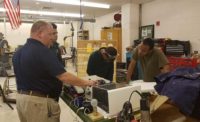Students Juice Nepal Villages and AEC Careers

Working on a hybrid wind and solar generator for a remote village in Nepal replicates a real-world work environment.
PHOTO BY DAVID MANGUS

Working on a hybrid wind and solar generator for a remote village in Nepal replicates a real-world work environment.
PHOTO BY DAYL WALKER, COURTESY CBIA

The student-built generators are transported via yak because the villages are inaccessible by car or railroad.
PHOTO COURTESY PETER WERTH



Two years after graduating from Hartford Public High School’s Academy of Engineering and Green Technology in 2011, Danilo Sena returned to participate in a new program that has students building hybrid wind and solar generators for Nepalese villages in the Himalayan Mountains. The program recently built its fourth generator for the remote village of Tinje, while Sena was inspired to earn a civil engineering degree and start a career in construction.
One of the only college students working on the Nepal 1.0 generator, Sena helped write instructions that villagers could understand and double-checked the high school students’ work.
The Brazilian immigrant performs similar tasks in his current job as a construction inspector for AI Engineers Inc., which he joined in 2015 after earning his degree from the University of Connecticut. He currently inspects rebar and formwork, tests concrete and inspects drainage systems on a 376,000-sq-ft bus-maintenance facility in Waterbury, Conn.
Edward Widofsky, a senior associate at Steffian Bradley Architects, sits on the Academy of Engineering and Green Technology’s board. He says the Nepal project replicates a professional environment. “There’s a client, there’s a site,” he says. “You have to know the community [the project] is serving and you have to figure out how it can be taken apart and shipped halfway around the world.” With villages inaccessible by car or railroad, generators had to be carried via yak for locals to assemble.
The program started after Connecticut philanthropist Peter Werth learned about the need for electricity on a Nepal hiking trip. He launched the project with support from the Connecticut Pre-Engineering Program and Connecticut Business and Industry Association (ENR 12/16/13, p. 14). The project is also supported by NAF, a national network of education, business, and community leaders working to prepare high school students from “high need communities” for college and beyond. Nepal 1.0 was funded with approximately $100,000 to cover equipment and student subsidies. Heating classrooms and powering laptops, the first generator electrified a village called Saldang for the first time.
Nepal 2.0 in 2015 involved about 20 students who built two generators, the year a magnitude 7.8 earthquake rocked the tiny nation. David Mangus, the science and engineering teacher who runs the Nepal project, says a government crackdown on corruption after the quake made it harder to ship the generators. “Now we have more hoops to jump through to convince folks that the power system is indeed a form of aid to the schools,” he says.
While the budget for the current Nepal 3.0 generator was only about $35,000, which allowed only 10 students to participate, he says builders of the next version will need to raise $30,000 to $40,000 by this fall to complete two new generators that will power a school and a medical clinic. Mangus says the government will give the clinic vaccines if a more robust generator can power a refrigerator.
That doesn’t daunt the Connecticut students, who are accustomed to achieving lofty goals. Mangus says 15% of the high school’s graduates take up engineering, three times the national average, despite the fact that many of its students have special education needs or are English-language learners. “Because of that background, people think … they are not willing to do [the work],” says Sena, who is the first member of his family to graduate from college. “If somebody does present the opportunity, everybody will show up, everybody will work.”
Related Article: Hartford High School Engineers Help Nepal Students Power Up






